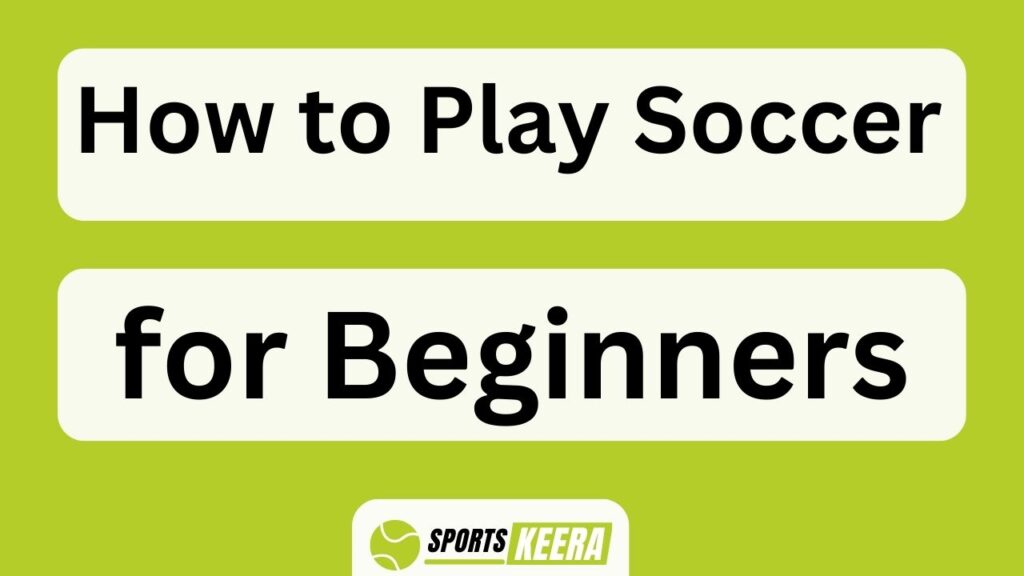Soccer, often referred to as ‘the beautiful game,’ is more than just a sport. It symbolizes the unity of players from different backgrounds, cultures, and abilities coming together on a field to chase after a common goal.
For beginners eager to learn this mesmerizing game, understanding the rules and mastering basic skills are essential first steps towards becoming a proficient player. This informative article will guide you through the fundamentals of soccer, providing you with a solid foundation to build upon.
From getting acquainted with the equipment and learning ball control techniques to improving agility and enhancing communication skills, each aspect will be explored in depth.
Additionally, small-sided games and drills will be introduced to help you apply your newfound knowledge in practical situations. With dedication, practice, and perseverance, you too can join the ranks of soccer players who have fallen in love with this captivating sport.
Key Takeaways How To Play Soccer For Beginners
- Understanding the rules and mastering basic skills are essential for beginners.
- Proper footwear and equipment knowledge are important for safety and performance.
- Dribbling and ball control skills are crucial for maneuvering and maintaining control.
- Small-sided games and drills are beneficial for skill application and development.
Understanding the Rules of Soccer
Now let’s dive into the nitty-gritty and understand the rules of soccer.
One key rule to grasp is the offside rule. This means that an attacking player can’t be nearer to the opponent’s goal line than both the ball and the second-to-last defender when receiving a pass. Understanding this rule is crucial for players to avoid penalties and maintain fair play on the field.
Another aspect to explore in soccer is different types of fouls and penalties. These can range from minor infractions, such as tripping or pushing an opponent, to more severe offenses like deliberate handballs or dangerous tackles. Familiarizing oneself with these fouls and their corresponding penalties will help beginners navigate game situations with confidence.
Moving forward, it’s important for beginners to get to know the equipment used in soccer. Transitioning seamlessly into our next section about equipment, players need a good understanding of how it all comes together on the field.
Getting to Know the Equipment
While stepping onto the soccer field, imagine yourself as a knight donning his armor, as you become acquainted with the gear necessary for this thrilling game. Proper footwear is essential in soccer to prevent injuries and maximize performance. Cleats provide traction on the grass, allowing players to make quick movements and cuts. It’s important to choose cleats that fit well and provide support for your feet.
Next, let’s explore different types of soccer balls. The size of the ball depends on the age group playing, ranging from size 3 for young children to size 5 for adults. The weight and material of the ball also vary, with synthetic leather being commonly used for match balls.
Understanding the importance of proper footwear and exploring different types of soccer balls will give beginners a solid foundation in equipment knowledge. Now, let’s move on to mastering basic ball control skills without delay.
Mastering Basic Ball Control Skills
To become a skilled player, it’s crucial to master the fundamental ball control skills. Dribbling techniques are an essential aspect of soccer that every beginner should focus on. Learning how to effectively move the ball with precise touches and quick footwork is key to maneuvering around opponents and maintaining control.
Beginners should practice dribbling with both feet, using the inside and outside of their foot, as well as practicing changes in speed and direction. Another important skill is maintaining ball possession. This involves shielding the ball from opponents by positioning your body between them and the ball, using your arms for balance while keeping your eyes up to scan the field for passing options or open spaces to exploit.
By mastering these skills, beginners will be well-prepared for learning different passing techniques in the next section about soccer fundamentals.
Learning Different Passing Techniques
You can enhance your skills by exploring various passing techniques, such as the lofted pass or the through ball – but have you ever wondered which one is more effective in creating scoring opportunities?
When it comes to passing accuracy techniques, both the lofted pass and through ball have their advantages. The lofted pass is a high-arcing pass that allows you to bypass defenders and deliver the ball accurately to your teammate. On the other hand, the through ball involves sending a precise ground pass into open space behind the defense, allowing your teammate to run onto it.
As for advanced passing strategies, knowing when to use each technique is key. Understanding the positioning of your teammates and opponents will help you determine whether a lofted pass or through ball is more appropriate in any given situation.
Now that you have mastered different passing techniques, it’s time to move on to practicing shooting and scoring goals without losing momentum.
Practicing Shooting and Scoring Goals
Ready to step up your game and become a scoring machine? To score goals in soccer, it’s crucial to have proper shooting technique. First, position your body correctly by aligning your non-kicking foot with the ball and keeping your head over the ball.
Next, use the inside or laces of your foot to strike the ball with power and accuracy towards the goal. Practice shooting from different angles and distances to improve your aim.
Additionally, work on creating goal-scoring opportunities by staying alert and anticipating plays. Make runs into open spaces, communicate with teammates, and take advantage of any openings in the defense. Remember to be patient and persistent when trying to score goals as it may require multiple attempts before finding success.
Transitioning into developing defensive skills and positioning, it’s important for beginners to understand how to effectively protect their own goal while also supporting their team’s attack.
Developing Defensive Skills and Positioning
Transitioning into the development of defensive skills and positioning, it’s crucial for individuals to understand how effectively protecting their own goal while supporting their team’s attack contributes to a well-rounded player.
To excel in this aspect of the game, players must learn proper tackling techniques and defensive strategies. Tackling is an essential skill that involves dispossessing opponents of the ball without committing fouls. It requires timing, technique, and physicality. Additionally, understanding defensive strategies such as man-marking, zonal marking, and pressing can greatly enhance a player’s ability to defend effectively.
Proper positioning is also key in different game situations. A defender needs to know where to position themselves on the field to intercept passes, block shots, and deny attackers space. This includes knowing when to step up or drop back based on the movements of opposing players.
As we move into the subsequent section about improving agility and speed, it’s important for beginners to remember that developing defensive skills and positioning is just one piece of the puzzle in becoming a proficient soccer player.
Improving Agility and Speed
After developing defensive skills and positioning, beginners can focus on improving their agility and speed on the soccer field. Speed training and agility exercises are essential for players to enhance their performance in various aspects of the game.
By incorporating these exercises into their training routine, beginners can improve their footwork, reaction time, and overall quickness. Speed ladder drills, cone drills, and shuttle runs are some examples of agility exercises that can help players become more agile and explosive.
To engage the audience further, here are two sub-lists:
Agility Exercises:
- Shuttle Runs
- Lateral Cone Drills
Speed Training:
- Sprint Intervals
- Resistance Band Sprints
By focusing on improving agility and speed, beginners will be able to move swiftly across the field, react quickly to different game situations, and outmaneuver opponents effectively. This will lay a strong foundation for enhancing communication and teamwork within the team dynamic.
Enhancing Communication and Teamwork
To really hit the ground running and become a force on the field, you’ll need to step up your game by enhancing communication and teamwork because no man is an island.
Improving communication is crucial in soccer as it allows players to effectively convey their intentions, coordinate strategies, and react swiftly to changing game situations. By building trust with your teammates, you create an environment where everyone feels comfortable expressing their ideas and opinions. This leads to better decision-making and a stronger bond among players.
Effective communication also helps prevent misunderstandings and reduces errors on the field. As we delve into the subsequent section about participating in small-sided games and drills, you’ll see how these skills directly translate into improved performance during match play without skipping a beat.
Participating in Small-Sided Games and Drills
Engaging in small-sided games and drills allows players to sharpen their skills and develop a better understanding of the game through active participation. These activities provide an opportunity for players to practice various techniques, such as passing, dribbling, shooting, and defending, in a more controlled setting.
Small-sided games also help players learn important strategies like maintaining possession, creating space, and working together as a team. Additionally, participating in drills specifically designed to improve soccer skills can greatly enhance a player’s performance on the field. These drills may focus on agility, speed, ball control, or specific aspects of the game like corner kicks or penalty shots.
By incorporating these strategies and drills into their training regimen, beginners can quickly progress in their soccer journey and continue to learn and grow as players without feeling overwhelmed by complex tactics or advanced techniques.
Transitioning into the next section about ‘continuing to learn and grow as a soccer player’, it is crucial for beginners to stay motivated and dedicated to practicing regularly.
Continuing to Learn and Grow as a Soccer Player
As you progress and develop as a soccer player, your journey becomes an exhilarating adventure of self-discovery and growth.
One important aspect of continuing to learn and grow as a soccer player is developing soccer IQ. Soccer IQ refers to the ability to understand and analyze game tactics, both on an individual level and as part of a team.
By studying different strategies, formations, and styles of play, you can gain a deeper understanding of the game and make more informed decisions on the field. This includes recognizing patterns, anticipating opponents’ moves, and making quick decisions under pressure.
Developing your soccer IQ will not only make you a more effective player but also enhance your overall enjoyment of the sport as you become more engaged in its intricacies.
Keep learning, practicing, and analyzing the game to reach new heights in your soccer journey!
Frequently Asked Questions
How do I choose the right soccer shoes for my playing style?
To choose the right soccer shoes for their playing style, beginners should consider the balance between comfort and performance. They can compare different brands and models to find the perfect fit that enhances their game.
What are some common mistakes beginners make when learning ball control skills?
Common mistakes beginners make when learning ball control skills include not keeping their eyes on the ball, using only one foot, and not practicing enough. To improve, beginners should focus on these areas and practice regularly.
How can I improve my shooting accuracy and power?
To improve shooting technique and increase shot power, beginners should focus on proper body positioning, using the laces of their foot to strike the ball, and generating power from the hips and core.
What are some effective defensive strategies and positioning techniques?
To effectively defend in soccer, players should employ various defensive tactics and marking techniques. These include man-to-man marking, zonal marking, and pressing the opposition. Proper positioning is crucial to intercept passes and block shots.
How can I improve my speed and agility on the soccer field?
To train for explosive bursts of speed and quick changes in direction, incorporate drills like ladder exercises and cone drills into your training routine. These will improve footwork and reaction time, enhancing your overall speed and agility on the soccer field.
Conclusion
In conclusion, for beginners looking to learn how to play soccer, understanding the rules and getting to know the equipment are crucial first steps. Mastering basic ball control skills and learning different passing techniques will help players become more confident on the field. Practicing shooting and scoring goals is essential for becoming a well-rounded player.
Improving agility and speed can give players an edge in competitive matches. Enhancing communication and teamwork skills will contribute to overall success as a team. Participating in small-sided games and drills allows for practical application of learned skills. Remember, learning and growing as a soccer player is a continuous process that requires dedication and perseverance.
One interesting statistic to note is that according to FIFA, soccer is played by over 265 million people worldwide, making it the most popular sport in the world. This highlights the global appeal of soccer and shows just how many people are involved in this exciting sport. So whether you’re just starting out or looking to improve your skills, remember that you’re joining millions of others who share your passion for the beautiful game of soccer.





